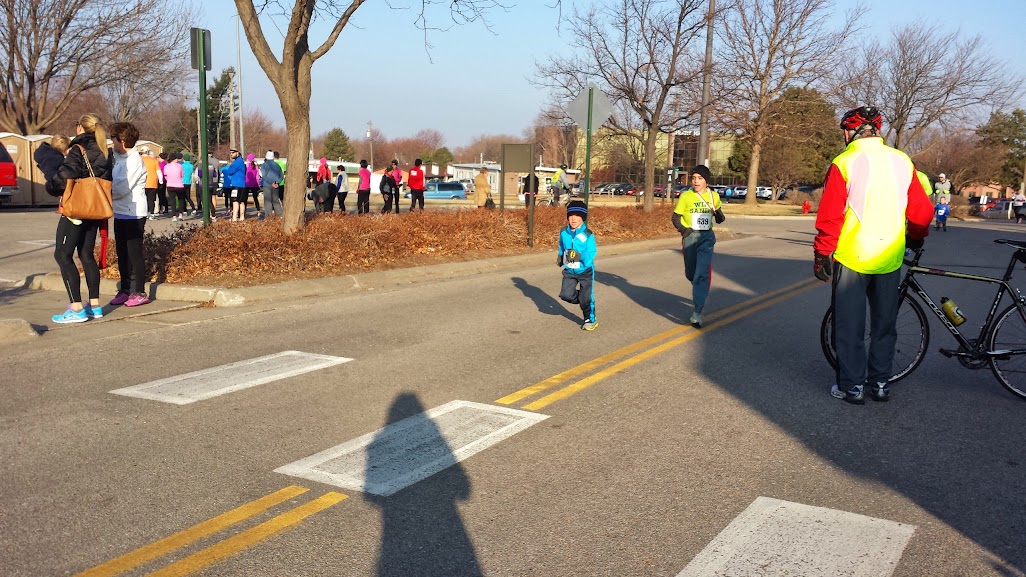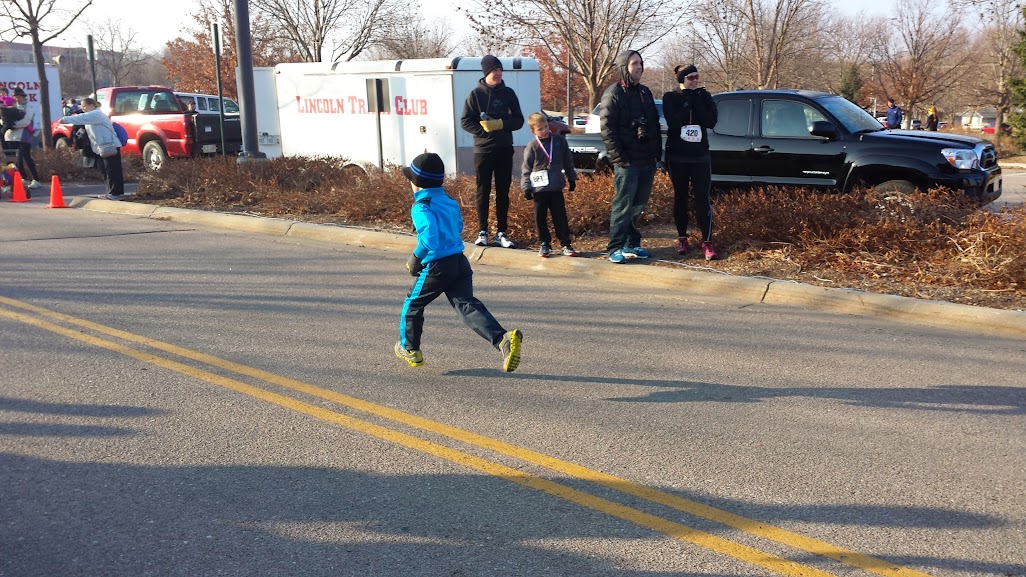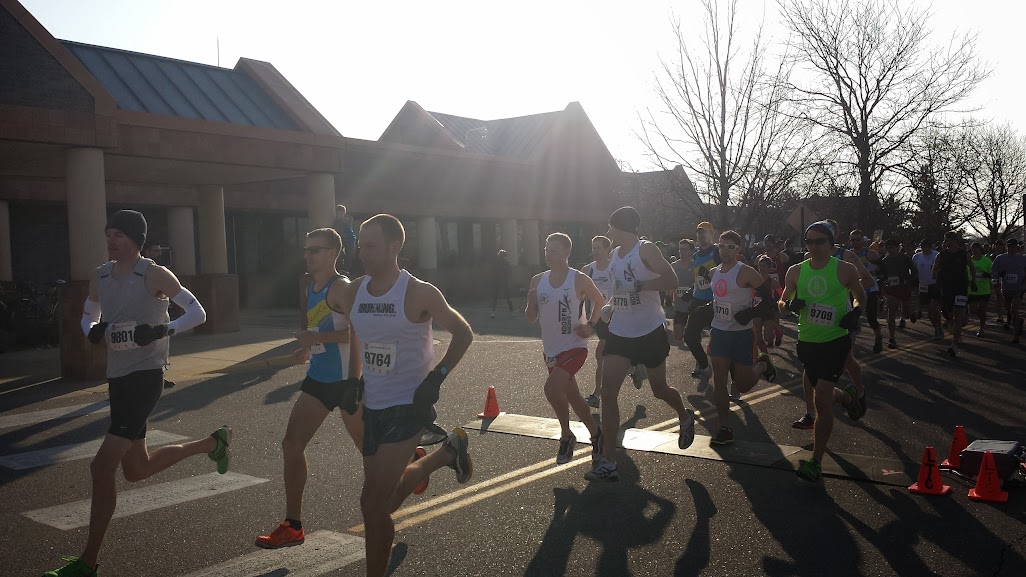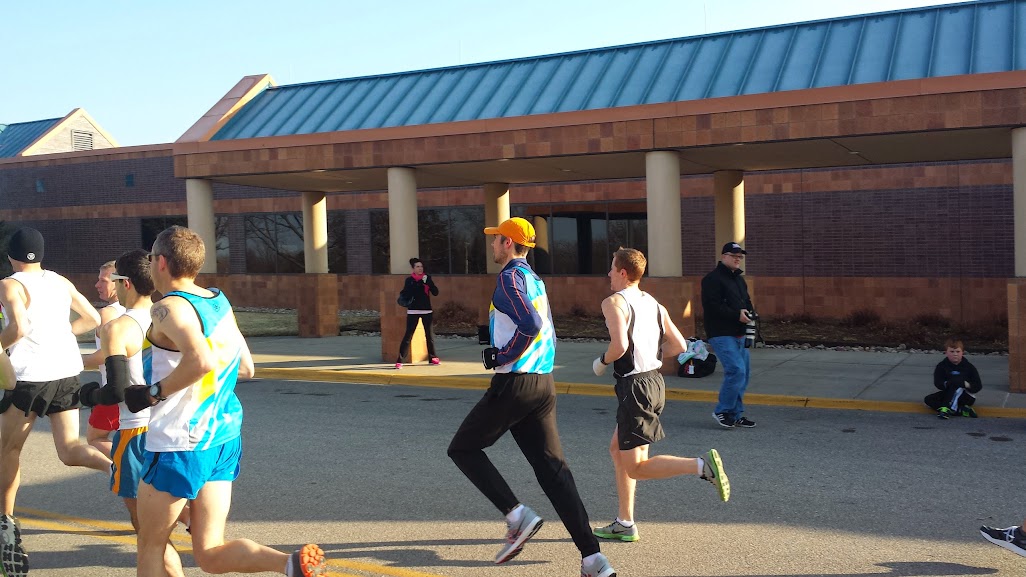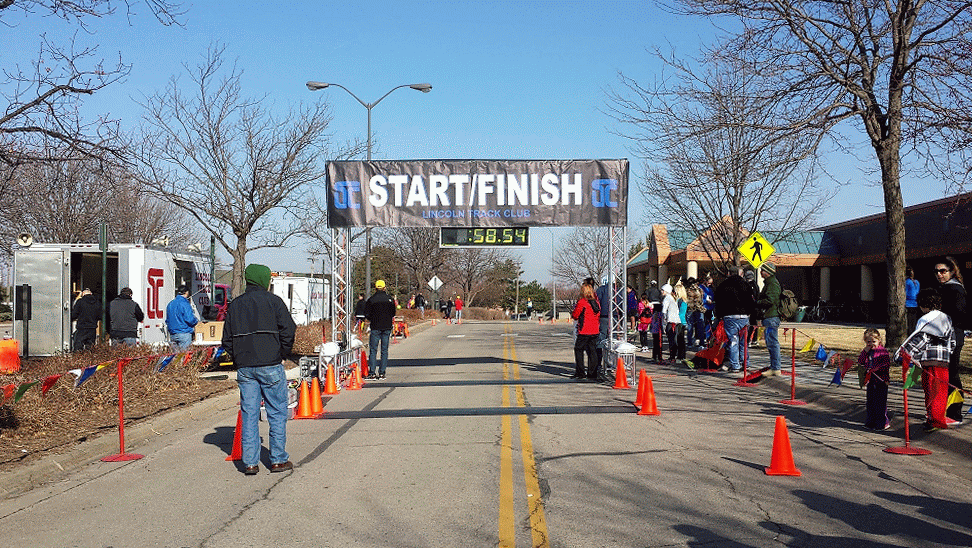I decided to make my third race of 2014 a long one. This would be my 50k debut and the first race of the year I felt fit enough to actually race. I chose the
Stampede 50k because it starts at Roca Berry Farm and runs into the Wilderness Park trails just 10 minutes from my house in Lincoln and I know the terrain pretty well. Nothing like sleeping in your own bed the night before a race.
My late 2013 and early 2014 training has been a bit spotty by my standards. I've been battling with a tight hamstring/inactive glutes (coincidentally the subject of many recent articles in running magazines) since September of 2013 when I had my DNF at the Quad Cities Marathon. I was in great shape, ran aggressive there (1:15:10 at the half marathon and about 1:57 at the 20 mile) and my hamstring tied up on me at mile 20 so I pulled the plug.
I've been squeezing my butt muscles in every way imaginable for the last few months to try to remedy my hammy situation. Things have improved lately so that I can run decent mileage again but any speedwork, and even tempo work, makes the hamstring tight and kills my stride.
If 2013 was about coming out of retirement, going hard and running mostly half marathons (and it was), 2014 for me is about going long, mixing in more trails and testing my limits another way.
So I was walking into this 50k with a few solid long runs (topping out at 25 miles) and for speed I had just a couple random short tempo runs on the treadmill and one "fast finish" long run. Luckily, trail 50k's don't usually come down to a sprint.
What I hadn't anticipated for a March 1 race was 5 degree temps and -30 windchill readings. So the week leading up to the race was about preparing gear and preparing mentally for those conditions. Luckily, I went to college in Minnesota so I had a pretty good idea of how to race in the cold. Wear layers and don't overdress. In a race situation, you will warm up even quicker than a normal run.
Below is what I wore on race day.
 |
| Super-cold 50k gear |
I went with 3 layers on both top and bottom. On top I went with a mid-weight Adidas ClimaFit t-shirt, mid-weight Asics half-zip and a Millet wind vest. Millet is a french company that makes great mountain/ski gear but this vest is similar to many on the market. I also put on some basic arm sleeves under my long sleeve shirt to keep my elbows warm (not pictured).
On my bottom half I went with my go-to combination for anything under about 20 degrees. Orca "Kompression" shorts, 2XU Compression tights, and basic Sporthill pants.
For footwear I went with a basic mid-weight cotton sock and my Skechers Go Run Ultra shoes. These shoes worked great for the varied terrain on this course---crushed gravel, grass, singletrack dirt. Review of these shoes coming to Respect The Run very soon!
For gloves I went with my Nathan "convertible" gloves with the little windsleeve mitten that pulls over the top. I could have gone with a warmer mitten but I needed to have my fingers to get at my fuel along the way.
On my head I went with my favorite hat. It's a Skitrab brand hat (yes, more ski gear). The thing I like about ski hats is they are very tight and keep the wind from coming up into your ears. No other hat keeps me as warm as this one. You can usually tell a good ski hat because it will have a little loop on top for hanging and it will be made of stretchy tech fabric.
I also wore a windmask that covers your nose and mouth, but I just pulled it down around my neck because I don't like covering my nose and mouth, especially in a race. But it made a nice neck-warmer.
 |
| The right hat and gloves go a long way. (About 31 miles in this case.) |
All this turned out to be the just the right amount of gear when I got going. If you are dressed right to race in cold weather, you should be cold at the start line...
On race morning I woke up about 2 hours before race time and had my usual race breakfast of a whole banana and a handful of Kix cereal right away. On my way out the door I stuffed my pockets with race fuel: 3 energy gels (I generally like them caffeinated), 3 oreo-style vanilla cookies, 6 or 8 Hammer Endurolytes salt caps, and a handful of chocolate covered coffee beans (I ate a few of these on the way to the race to give me a little caffeine in my system). I told my wife and kids just to stay home rather than come out and watch me in the harsh conditions.
I got to the race site, grabbed my number and did a 10 minute light jog. I wanted to get some blood moving but not really get sweaty. I knew there would be some waiting for instructions at the startline and I didn't want to get sweaty and "ice up" before the race.
The actual start/finish line was located in a barn on the Roca Berry Farm property. We are talking an old, non-insulated barn. They had a couple of kerosene heaters in there which raised the temp inside to probably 25 or 30 degrees but it was still pretty cold.
Just before 8am, RD Jim Craig started giving pre-race instructions in the barn to about 60 or 70 of us (there was also a 5 mile and 15 mile offering that day). The gist of Jim's talk was not to kill yourself out there and dropping out after the first 15+ mile loop was very acceptable today considering the harsh conditions.
Don't kill yourself. Good advice. Jim also said that the clock and finish line volunteers would stay inside the barn so finishing would literally mean unlatching the barn door, walking in and announcing yourself. Insert joke about leaving the barn door open....
We stepped outside to the start and Jim Craig sent us on our way. I decided to carry my Nathan handheld and no other fluids. As I suspected, my bottle's mouthpiece started to freeze up about a mile into the race and I just tossed it into the ditch. Some upstanding citizen grabbed it and it appeared back at the finish line after the race.
Off the starting line,
Jeremy Morris , an accomplished ultra runner took the lead. He went about 6:20 for the first mile while myself and
Aaron Norman , another seasoned ultra guy, were more like 6:30. There was no one else really giving chase. Norman and I decided to let Morris go and settled in around 6:50 pace while we talked about family, races we had run, etc.
My goal going in was just to break 4 hours and I didn't want to get sucked into Morris's pace. So Norman and I headed north running side by side into the wind on the crushed gravel rail trail.
Norman was wearing an ultra vest which carried 2 bottles on the front for most of the race, although he wasn't getting much out of them because the liquid was turning to slush and the mouthpieces were freezing up. It looked like Morris had a belt on carrying a water bottle in back. I was planning to rely on the aid stations since my handheld had frozen.
The course was set up with small aid stations at about miles 5.5, 8, 9, 11.5, 15 and then the same sequence on lap 2. So plenty of aid for this type of race. The course was roughly 10% dirt/gravel farm road, 45% crushed gravel rail trail, 45% singletrack wooded trail. There was one dry creek crossing at mile 8/mile 23.
I grabbed a small bottle of water with a twist off top at 5.5 mile aid station and carried that with me for several miles. It wasn't freezing up because of the constant movement. I took a GU around mile 6 and it was very thick and I had to warm it inside my glove to get most of it out. Norman and I continued to hold pace just under 7 minute miles even on the singletrack sections. Between miles 6 and 8 we noticed that we were slowly reeling Morris in. Norman and I passed him just after the creek crossing around mile 8. We exchanged a few words but Morris didn't seem to have much fight as we passed him. We found out later that Morris had overdressed and he ended up shedding a layer at the mile 9 aid station.
Norman and I both passed on aid at miles 8 and 9 because we both still had water and calories on us.
We were still working together and I ate a few coffee beans and then a couple oreo cookies around mile 10. My face was frozen and chewing was not pleasant but I managed to get the calories down. I grabbed another small bottle of water at the 11.5 aid station.
About 15 miles in, as we approached the halfway point aid station at the barn, Norman and I agreed to stop and leave the station together so we could continue to work together. It's definitely a valid race tactic to leave another racer behind who is slower at an aid station, or to simply skip an aid station where another racer is stopping to make up time, but this wasn't a day that either of us wanted to go it alone out in the wind.
I needed a bathroom break and a bottle of water, and Norman really wanted to refill his frozen water bottles. We didn't stop at the barn for more than 2 minutes or so and I was ready to go again. Pete Kostelnick, my sometimes long run partner, had opened my water for me (my hands were half-frozen) and got me ready to go again quickly.
Norman was now standing outside the barn and fumbling to get the lid on his water bottle, it kept leaking.
We started to jog out and he was still fiddling with the water bottle. I can't remember if I told him just to drop the bottle and run, but I wanted to. He finally told me to go ahead and leave without him.
This was when my racing instincts kicked in. As I took off from the barn I picked up my pace down the farm road back to the rail trail. When I turned onto the rail trail I shifted gears and ran about 3.5 miles at 6:20 pace despite running straight north into the wind. I didn't look back for a few miles. I was encouraged along the way by the other runners in the race coming back toward the halfway point. Somewhere during that hard stretch I passed Kyle Clouston, who was leading the 15 mile race and going the opposite direction. I called out asking him how much of a lead I had. He said a minute or so, hard to tell.
I blew past the 19 mile aid station for fear of losing my lead, which was a bad call. I still hadn't taken my Endurolytes (salt pills) and I started to see spots on the singletrack between that station and the 22 mile station. I didn't feel too bad, I just couldn't see clearly. I needed salt.
This had happened to me in the desert in January of this year so I knew what was going on and I didn't freak out. I didn't stop to walk either. I just slowed up slightly and concentrated on each turn in the trail using what I could see to guide me. I couldn't see my feet below me so I was turning with my body more than aiming my steps like I would normally do on a trail like this with tree roots and walnuts that need to be avoided. I knew this stretch of trail well but I still got very lucky flying blind for those couple miles until mile 22 where I stopped for a minute or two and finally took some salt. My recovery when I took the salt pills was almost immediate, within a few minutes anyway. My vision came back and I could turn my attention back to finishing the race.
In a race like this you would normally have some friends or family out on the course cheering and telling you what your lead or deficit is. But the conditions were so brutally cold that it wasn't realistic for spectators to be outside.
Norman hadn't caught up to me while I was stopped taking my salt like I worried he might. He was apparently back more than the minute or two I had stopped at the aid station. I jumped back on the course and was running around 7 minute pace again between miles 22 and that final aid station around mile 26. During these miles I passed Morris and saw that he was having a really bad day, at least 20 minutes behind me. I also saw Kaci Lickteig out on the course near Morris. She is a top national ultra runner on the women's side, having placed 2nd at the national 100 mile championships at Rocky Raccoon in Texas just a few weeks before this Stampede 50k. She was probably just getting back into doing long runs after her huge 100 mile effort.
When I rolled out of the woods and into that last aid station, the race was mine to lose. The RD had driven to the aid station to tell me I had to do the loop around the farm, not just run straight to the barn, before I finished. Basically an extra mile or more that I hadn't mentally prepared for. Not news I wanted to hear.
The volunteer at the aid station helped me open some sports drink and water. I knew I had at least a few minutes of cushion on Norman. This should have been comforting but really wasn't. I was feeling pretty drained. My hamstring was feeling tight and I hoped it wouldn't fail me. I'd never run further than 26 miles before. I was there now on the doorstep where a marathon turns into an Ultramarathon. Me and some other crazies out running around in the cold on a perfectly good Saturday.
But as I started to run again my legs weren't all that tired. The battle was mostly mental. My mind kept telling me just to stop and walk for a minute, it will feel great. Just putting one leg out in front of the other was a battle those last few miles but I knew I couldn't stop and walk or I might not start again. I ignored my watch as it informed me I was ticking off miles 27, 28, 29. I just looked ahead to the next stand of trees and focused on reaching it. Then I told myself to do it again.
I know my last 5 miles weren't my fastest but I pushed through and got back to the berry farm where I had to do one last lap around the farm before finishing. The last mile I imagined spectators lining that rough farm road as though it were the finish of a major marathon. Luckily, the last 100 yards or so of the race were a slight downhill and it made reaching the barn easy.
I opened the barn door, walked in and simply said "I'm in." I had won the Stampede 50k.
My time was 3:32:04. I was pleased with that considering the conditions and my doubts about my own fitness going into the race.
The next hour I sat inside the barn next to a kerosene heater and tried to get warm by drinking hot chocolate and a little beer. I felt like garbage. But what do you expect after running 31 miles out in frigid conditions?
I was somewhat out of it for that hour and I finally realized I was just so cold that I needed to leave the barn and really warm up in my car. So I headed out to the car, warmed up for a bit and then just drove home. I'd intended to go back inside and eat more food, but getting up from the warm car seat wasn't going to happen. I got home and took my temperature. It was still about 1.5 degrees low. I hydrated, napped and felt much better in a few hours.
I "Respected The Run" by giving my body a few days off and then only running about 30 miles the week after the race. I pretty much resumed full training after that down week. I have the Lincoln Marathon on my schedule in early May.
Big thank you to RD Jim Craig at Angry Cow Adventures and also to Morris, Norman, Kostelnick, and everyone else in attendance that day. See you further down the trail!
